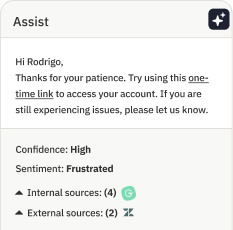9 workforce management best practices

Though it began humbly as a way to estimate customer needs and create schedules accordingly, workforce management (WFM) has grown to become a proven and trusted practice for many industries to help maximize employee output while decreasing the overall budgets. As consumers become more demanding, contact centers are relying even more heavily on WFM to provide quality service.
9 Best practices for workforce management in a call center
Even if you already have a WFM program in place, there are important ways to maximize its results. We’ll review call center WFM best practices that will help set your team up for success. Don’t worry, they’re totally practical and can be deployed today!
1. Create a team dedicated to improving WFM within your contact center
The best WFM plan includes a dedicated WFM specialist or team within the contact center. Their role is to forecast staffing needs, handle scheduling, monitor agent performance, and analyze data. Think of this person or team as your call center’s future-teller, catching issues before they arise and spotting positive contributions, too. They need to be able to track current and historical data in order to spot promising trends and recognize areas for improvement.
In order to accomplish this, your WFM team will also need a software system that offers real-time data visualization and historical analytics. Workforce management software, like Assembled, is a game-changer for its ability to quickly build forecasts that are incredibly accurate, which is a must-have when working towards optimized scheduling. This is one of many features that would assist your WFM team with its duties.
In short, a WFM team and WFM software work hand-in-hand to truly be effective and scale in the future.
2. Treat all agents fairly
Let’s face it, even the fanciest tools money can buy don’t guarantee that your call center will run smoothly. Without support professionals, your call center is nothing. It’s important to recognize that your team is the heart of your call center and to make sure they are treated as such. Contact centers tend to have very high turnover due to job stress and generally low job satisfaction levels. Employee attrition rates for this role are between 30-45%, or even as high as 50% for BPOs.
Fortunately, you can reduce it by providing transparency when making decisions, and giving employees some control over their schedules. A simple way to show your support professionals how valuable they are is to also offer opportunities for continued growth and improvement, and lead with a bit of empathy.
It isn’t always easy to balance flexibility for employees with the needs of the company, but it's a worthwhile challenge to take on.
3. Enable employee self-service
When it comes to offering employees methods of power over their schedules, self-service tools are extremely helpful. These tools offer employees some control, which can contribute to employee satisfaction. Bonus: it also removes a few tasks off of managers’ overloaded plates.
When choosing the best workforce management software for your business,, prioritize those that are built for the whole team, like Assembled. Our powerful scheduling feature gives agents the power to request time off, swap schedules with other employees, and even self-schedule.
4. Forecast call volume and schedule accordingly
Scheduling the right number of agents for each shift is a necessity to serve customers and stay on budget. After all, it’s not uncommon for customers to complain about one negative experience, even if several previous interactions were positive.
Properly forecasting call volumes ensure that you are prepared and both your customers and employees are provided with a great experience. Putting this best practice in place takes your WFM to the next level by promoting employee advocacy and improving customer care.

5. Account for “shrinkage”
When forecasting staffing requirements, don’t forget to account for the amount of time when agents are not able to actively serve customers. Support professionals will need to step away to take breaks, lunches, additional training, and more. The best WFM plans look at historical shrinkage data—which is between 30% and 35%—and then balance it accurately into the current forecasts. If this additional time is not tracked, there’s a chance that your center may be understaffed, your employees may be overwhelmed and your customers less than satisfied. More accurate schedules will ensure that there is enough coverage in place at your busiest times.
6. Set realistic targets and track them
A well-optimized WFM strategy ensures better access to data, which call centers can use to track the metrics that measure productivity, labor utilization, and ensure compliance. Centers can utilize automated, self-service time reporting systems to reduce data errors, as well as keep track and monitor absences against planned schedules, which helps to optimize forecast productivity lapses. This enables the center to better manage employee absences.
Keeping track of the right data ensures you can track and measure progress. Fortunately, Assembled’s robust analytics dashboard helps centers keep up with metrics like schedule adherence, allowing them to be tracked in real-time, so any missteps can be quickly caught and addressed. The transparency into the performance of the entire contact center is vital to meeting and exceeding KPIs and continued improvement.
7. Collect quality data
Forecasting and scheduling depend on timely, accurate, quality data. Traditional WFM relies on historical data to make predictions about future patterns, so the more data there is the more accurate those predictions become. Integrating WFM software with other tools your center is using, like an ERP for example, can help in understanding demand and meeting employee and customer expectations. This means your scheduling becomes more accurate and your savings skyrocket as you reduce operating costs.
8. Focus on continuing education and training for managers and employees
It’s important for employees to feel that they aren’t just another cog in the corporate wheel. Show your appreciation for their hard work by helping them take on more responsibilities and even work their way up the company ladder. Nearly 75% of agents are eager to learn new skills and complete refresher training to expand and sharpen their skillsets.
Continuing education ensures that agents feel comfortable and confident utilizing new technology and processes, like live chat and email. The more confident agents are in their capabilities, the better they will be at their jobs, which increases customer satisfaction as well as employee retention.
9. Work smarter with WFM software
WFM software is a necessity for maximizing your call center’s productivity. It improves efficiency, removes the need for managers to complete excessive manual tasks, and provides visibility for all team members. In short, WFM software helps you do more with less.
It also helps call centers accurately track time and attendance, which is important when reviewing employee performance, providing a detailed view of when an agent is doing excellent work or has some areas to improve. Other functionalities include making sure that employee information is always up-to-date and tying relevant workforce management data and metrics to each support staff. WFM helps managers focus on core business tasks and allows support professionals better control over their schedules and more visibility of performance targets.
Maximize your WFM today
Workforce management is a leading strategy that helps call centers handle increasingly demanding and knowledgeable consumers who have more methods to contact you and less patience. The best practices detailed above will help you maximize the success of your WFM program and tools, which in turn will improve call center customer service.
Reliable and agile software is also a necessity to really be effective, and scale, as this is impossible to do when operating with spreadsheets. Assembled was designed to meet the specific needs of call centers and support professionals to provide a responsive, empathetic customer service experience. It also offers intuitive and streamlined ways to schedule, forecast, and track the performance of your agents in real-time and beyond.
Better yet? Assembled is cloud-based and has the ability to integrate with commonly used platforms like Zendesk, Kustomer, Slack, and Google Calendar. These integrations create an environment for seamless implementation and nurture a more productive work experience. We know you’re intrigued. Schedule a tour today!





